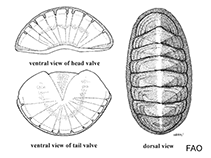Ischnochiton comptus (Gould, 1859)
Fancy chitonWarning: DOMDocument::load(): SSL operation failed with code 1. OpenSSL Error messages: error:140770FC:SSL routines:SSL23_GET_SERVER_HELLO:unknown protocol in C:\Apache24\htdocs\includes\SpeciesSummary.lib.php on line 1236
Warning: DOMDocument::load(): Failed to enable crypto in C:\Apache24\htdocs\includes\SpeciesSummary.lib.php on line 1236
Warning: DOMDocument::load(https://sealifebase.nrm.se/webservice/AquaMaps/getAMap.php?genus=Ischnochiton&species=comptus): failed to open stream: operation failed in C:\Apache24\htdocs\includes\SpeciesSummary.lib.php on line 1236
Warning: DOMDocument::load(): I/O warning : failed to load external entity "https://sealifebase.nrm.se/webservice/AquaMaps/getAMap.php?genus=Ischnochiton&species=comptus" in C:\Apache24\htdocs\includes\SpeciesSummary.lib.php on line 1236
Hochladen Photos
Google Bild | No image available for this species;
drawing shows typical species in Ischnochitonidae.
Google Bild | No image available for this species;
drawing shows typical species in Ischnochitonidae.
Classification / Names Common names | Synonyms | CoL | ITIS | WoRMS
| Chitonida | Ischnochitonidae
Environment: milieu / climate zone / depth range / distribution range Ökologie
. Subtropical
Verbreitung Länder | FAO Gebiete | Ecosystems | Vorkommen | Einführungen
Western Pacific: Japan, south to the Philippines.
Length at first maturity / Size / Gewicht / Alter
Maturity: Lm ? range ? - ? cm Max length : 2.5 cm TL Männchen/unbestimmt; (Ref. 283)
Kurzbeschreibung Morphologie
Valves broad; mostly light grayish brown; variously blotched with white, cream, pink, reddish chestnut or blackish brown; some specimens are olive colored mottled with white. Valve surface microgranulose, sculptured with numerous weak, glossy, radiating riblets. Girdle scaly and colored in alternating yellowish and grayish or brownish bands.
Found from intertidal to 50 m, on rocks and gravel (Ref. 75835). Also found under stones, just before Sargassum (Ref. 128661).
Life cycle and mating behavior Geschlechtsreife | Fortpflanzung | Ablaichen | Eier | Fecundity | Larven
Members of the class Polyplacophora are mostly gonochoric. Life cycle: Eggs hatch into lecitotrophic planktonic trocophore larvae (no veliger stage) which later metamorphose and settle on the bottom as young adults.
Hauptreferenz
Referenzen | Koordinator | Partner
Burghardt, G. and L. Burghardt. 2006. (Ref. 283)
IUCN Rote Liste Status (Ref. 130435)
CITES Status (Ref. 108899)
Not Evaluated
CMS (Ref. 116361)
Not Evaluated
Bedrohung für Menschen
Harmless
Nutzung durch Menschen
| FishSource |
Tools
Mehr Information
Internet Quellen
BHL | BOLD Systems | CISTI | DiscoverLife | FAO(Publication : search) | Fishipedia | GenBank (Genom, nucleotide) | GloBI | Gomexsi | Google Books | Google Scholar | Google | PubMed | Tree of Life | Wikipedia (Gehe zu, Suchen) | Zoological Record
Estimates based on models
Preiskategorie
(Ref. 80766):
Unknown.



